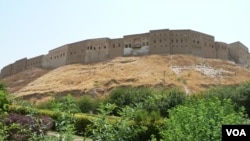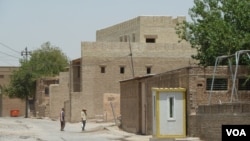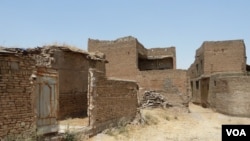Irbil, Kurdistan, northern Iraq today is a gleaming city growing daily toward the sky. But the soul of this city, and of Kurdistan, is held in a special place high above today’s frenetic development and streets filled with new luxury cars.
More than 4,000 years ago, maybe longer, people in what is now Kurdistan, looked up at a steep hill and decided that it would be the perfect place to build a citadel, and within it, establish a settlement.
Long before the time of the Prophet Mohammed, and many of those spoken of in the Bible, this place on the hill was named in honor of four Gods that people there worshipped. This settlement was called “Arba Ilo” – Arabic for “Four Gods” – which, of course, became the name Irbil. Or, as spelled sometimes, Erbil.
The founders of Arba Ilo were smart strategists. As you can see in the photos, the citadel’s hill is so steep that horses could not climb it to enable attacks. And, the height of the hill made arrows useless. Gunpowder, and cannons to use it, only came in the last 500 years. So for some 3,500 years, the only way to defeat those in the citadel was to starve them out. In the 1300s, Mongol invaders laid siege to the citadel for 45 days without success, though the part of Irbil at the foot of the mount was shattered. Life was fairly secure.
The citadel was built of mud brick, baked in ovens until strong. The weather was kept out of its buildings and homes with roofs made of thick limbs from trees, covered with palm fronds in crisscrossed layers, and covered again with other vegetation and earth. So close to the sky, yet, sealed from its intrusions.
From the citadel, roads fanned out to Turkey and Persia, placing Irbil in the crossroads of regional commerce, which gave Irbil purpose, and prosperity. Fertile valleys not far away provided the food that nourished this settlement, while the Tigris flows nearby to the west.
Countless generations walked the narrow streets of the citadel, their children becoming the parents of more. And, slowly, the ground around the steep mount began to become filled with more inhabitants as the city evolved into the predecessor of itself today.
As time went on through the centuries, the citadel remained the center of Irbil, though its importance slowly declined. By the 20th century, it still held inhabitants, but fewer and fewer as the decades went on.
I first climbed the hill to the citadel and walked its streets in 2004. There were still families there, along with their chickens and a few goats. The buildings by then had been worn down by wind and time, some of them now collapsed into crumbles. But to all in Irbil, it was still the center of their city, and history. Walking about, I deeply felt the soul of this place, and sensed the footsteps of thousands, over the millennia, who also scuffed the dust that had been there since Ibrahim.
When I returned in 2005, I saw families there again, but even in one year there had been more of it lost. It was a place where those remaining were largely poor, unable to buy into the prosperous city that lay at the citadel’s base.
Wanting to begin the arduous challenge of restoring this most ancient place, the Kurdistan Regional Government decided in 2007 that it was time to empty the citadel of its inhabitants. The government provided new places for them to live, and other assistance. And once they departed, the citadel was left for the winds to carry little grains of it to places far away.
Preserving and restoring something 4,000 years old of hard mud was an arduous challenge. Slowly, carefully, its gates and buildings had to be taken apart brick by brick, and then reassembled with new mortar and wood. Everything, of course, is so fragile – so each little piece had to be worked on by hand. The tap of a hammer could be fatal.
By 2014 the work was well underway. Significant parts of it, such as its massive main gate, have been reconstructed to look the way they’ve always been. But there are still many crumbled parts to put back together.
Just recently, the efforts of the citadel’s preservationists have been given a profoundly important recognition. UNESCO, the United Nations agency, has now declared Irbil’s citadel to be a World Heritage Site. This brings new energy, money, and attention to the task of bringing the citadel back to life.



